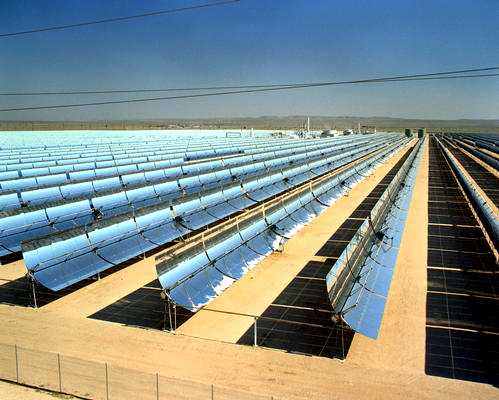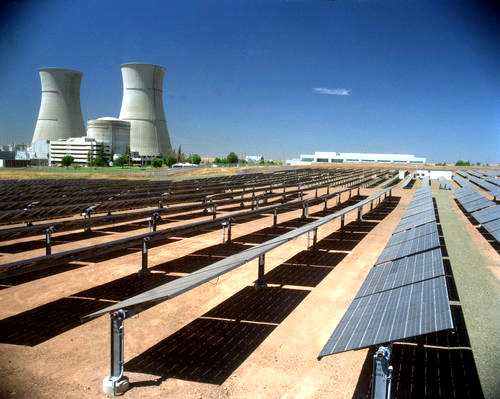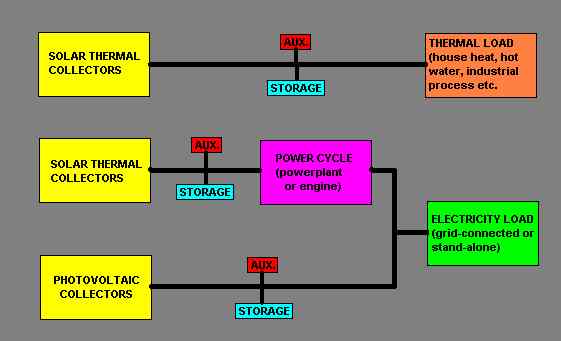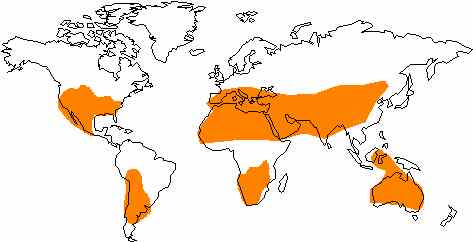William B. Stine, Michael Geyer
1. Solar Energy Conversion Systems
The largest solar electric generating plant in the world produces a maximum of 354 megawatts (MW) of electricity and is located at Kramer Junction, California. This solar energy generating facility, shown below, produces electricity for the Southern California Edison power grid supplying the greater Los Angeles area. The authors' goal is to provide the necessary information to design such systems.
The solar collectors concentrate sunlight to heat a heat transfer fluid to a high temperature. The hot heat transfer fluid is then used to generate steam that drives the power conversion subsystem, producing electricity. Thermal energy storage provides heat for operation during periods without adequate sunshine.
 |
|
| Figure 1.1 | One of nine solar electric energy generating systems at Kramer Junction, California, with a total output of 354 MWe. (photo courtesy Kramer Junction Operating Company) |
Another way to generate electricity from solar energy is to use photovoltaic cells; magic slivers of silicon that convert the solar energy falling on them directly into electricity. Large scale applications of photovoltaic for power generation, either on the rooftops of houses or in large fields connected to the utility grid are promising as well to provide clean, safe and strategically sound alternatives to current methods of electricity generation.
 |
|
| Figure 1.2 | A 2-MW utility-scale photovoltaic power system co-located with a defunct nuclear power plant near Sacramento, California. (photo courtesy of DOE/NREL, Warren Gretz) |
The following chapters examine basic principles underlying the design and operation of solar energy conversion systems such as shown in Figure 1.1 and 1.2. This includes collection of solar energy, either by a thermal or photovoltaic process, and integration with energy storage and thermal-to-electric energy conversion to meet a predefined load. Study of the interaction of these subsystems yields the important guidelines for the design of optimal solar energy systems. System design tools are provided to produce optimal sizing of both collector field and storage so that optimum system designs can be produced.
Since our emphasis is on the design of entire solar energy conversion systems rather than design of its individual components, both thermal and photovoltaic systems are included. This novel approach results from recognition of the commonality of most system design considerations for both types of solar energy systems. We will not dwell on the intricacies of individual component design, but instead encourage the designer to take experimental (or predicted) component input/output information and incorporate this into an overall system design.
The system shown in Figure 1.1 employs parabolic trough line-focus collectors. We will cover this and other types of collectors for capturing the sun's energy including flat plate, parabolic dish, central receiver and photovoltaic collectors. The purpose of a solar collector is to intercept and convert a reasonably large fraction of the available solar radiation. For solar thermal systems this energy is converted into thermal energy at some desired temperature and then, maybe, into electricity.
For photovoltaic systems as shown in Figure 1.2, intercepted solar energy is converted directly into low voltage direct current electricity. The engineering tradeoff between cost and performance of the components necessary to perform these processes has led to a wide variety of collector and system designs. Reviews of solar collector designs representative of the different concepts that have been built and tested are presented here.
The following sections serve as an overview of the solar energy system design process. They follow in a general manner, the flow of logic leading from the basic solar resource to the definition of an operating solar energy conversion system that meets a specified demand for either thermal or electrical energy.
1.1 The Solar Energy Conversion System
There are many different types of solar energy systems that will convert the solar resource into a useful form of energy. A block diagram showing three of the most basic system types is shown as Figure 1.3. In the first diagram , the solar resource is captured and converted into heat which is then supplied to a demand for thermal energy (thermal load) such as house heating, hot water heating or heat for industrial processes. This type of system may or may not include thermal storage, and usually include an auxiliary source of energy so that the demand may be met during long periods with no sunshine.
 |
|
| Figure 1.3 | Diagram of a basic solar energy conversion systems. The AUX. box represents some auxiliary source of thermal or electrical energy. |
If the demand (load) to be met is electricity (an electrical load) rather than heat, there are two common methods of converting solar energy into electricity. One method is by collecting solar energy as heat and converting it into electricity using a typical power plant or engine; the other method is by using photovoltaic cells to convert solar energy directly into electricity. Both methods are shown schematically in Figure 1.3.
In general, if solar energy conversion systems are connected to a large electrical transmission grid, no storage or auxiliary energy supply is needed. If the solar energy conversion system is to be the only source of electricity, storage and auxiliary energy supply are usually both incorporated. If the thermal route is chosen, storage of heat rather than electricity may be used to extend the operating time of the system. Auxiliary energy may either be supplied either as heat before the power conversion system, or as electricity after it. If the photovoltaic route is chosen, extra electricity may be stored, usually in storage batteries, thereby extending the operating time of the system. For auxiliary power, an external electricity source is the only choice for photovoltaic systems.
1.2 The Solar Resource
The basic resource for all solar energy systems is the sun. Knowledge of the quantity and quality of solar energy available at a specific location is of prime importance for the design of any solar energy system. Although the solar radiation (insolation) is relatively constant outside the earth's atmosphere, local climate influences can cause wide variations in available insolation on the earth’s surface from site to site. In addition, the relative motion of the sun with respect to the earth will allow surfaces with different orientations to intercept different amounts of solar energy.
Figure 1.4 shows regions of high insolation where solar energy conversion systems will produce the maximum amount of energy from a specific collector field size. However, solar energy is available over the entire globe, and only the size of the collector field needs to be increased to provide the same amount of heat or electricity as in the shaded areas. It is the primary task of the solar energy system designer to determine the amount, quality and timing of the solar energy available at the site selected for installing a solar energy conversion system.
 |
|
| Figure 1.4 | Areas of the world with high insolation. |
Just outside the earth's atmosphere, the sun's energy is continuously available at the rate of 1,367 Watts on every square meter facing the sun. Due to the earth's rotation, asymmetric orbit about the sun, and the contents of its atmosphere, a large fraction of this energy does not reach the ground. In Chapter 2, we discuss the effects of the atmospheric processes that modify the incoming solar energy, how it is measured, and techniques used by designers to predict the amount of solar energy available at a particular location, both instantaneously and over a long term.
To be continued
